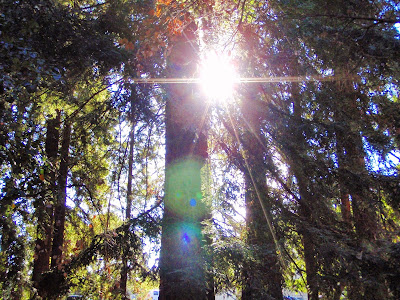Several Sundays ago I attended two concerts in a row of sacred choral music (some of it officially sacred, all of it sanctified): Magnificat with Schütz's Opus Ultimum at St Mark's Lutheran at 4:00 PM and then, skipping the Magnificat après-concert reception and rushing across the street to the Cathedral, Cappella SF at 6:00 PM with a program called Autumn Light, progressing, as my favorite season does, from the last bright glow of summer to the somber inward reflectiveness of on-coming winter. Altogether that was about three hours of (like an old-school Puritan) sitting on hard pews and paying attention to the divine words. But to hear unified human voices, on what started out as a hot and miserable day, conducting us (as Virgil did Dante) into a sacred realm. . . It was well worth the sore behind and the rushing and the worrying about time and the cost of the tickets. When I left the second concert, there was a cool and blessed wind blowing, and the day's heat and aggravations had, if not vanished, moved somewhere else.
In his talk beforehand, Stewart discussed feeling somewhat stymied at the task, until a German colleague of his said, "Well, this is how you'll do it this time!" – with the implication that there will be another time, another opportunity. This sense of the provisional can be oddly freeing. Stewart did a beautiful job, and his introductory talk gave some helpful guides for listening, and as a result the concluding doxology of each section (Glory be to the Father, and to the Son, and to the Holy Ghost, As it was in the beginning, is now, and ever shall be, world without end, Amen) sounded like the guide and blessing it was meant to be.
Magnificat used one voice per part, and the words came through in a clear and meaningful way, with passionate, committed declamation. The sun burned through the windows as we started, and was declining by the end. It was hot in the church, and paying sustained attention can be exhausting, but there was a sustained and enthusiastic burst of applause at the end. There was a reception afterwards in the lower level of the church, but instead I rushed across the street to the cathedral to buy a ticket for another concert (I had actually not bought tickets for either concert in advance, not sure if I would be able to get to either one).
It turned out I was there in a good amount of time, so I sat in the cathedral, which I haven't been to in a while, just gathering my thoughts. We, the audience for Cappella SF, were in only one section of the arrayed pews, and I vaguely thought about going over to one of the far corners of the church where I could let the sound wash over me in delightful and splendid isolation. But I stayed where I was, figuring that the baffles behind the chorus indicated that the sound would be best if I stayed put, on the aisle in my pew. For Magnificat I had sat up close. That may account for the dramatic vividness of the one sound and the more blended sound of the other. There was interesting variety in the different sounds, each enticing in its own way.
Ragnar Bohlin, the conductor of the redoubtable San Francisco Symphony Chorus, is the artistic director of Cappella SF. His interesting and well-chosen selections were mostly from northern parts; we started with Bach's Singet Dem Herren, followed by Josef Rheinberger's Mass in E-Flat Major, Op 109, Ingavr Lidholm's De Profundis (an interesting mixture of the old prayer with texts by Strindberg), Arvo Pärt's Sieben Magnificat Antiphonen, and concluding with the solemn thoughts of Schnittke's Psalms of Repentance, No. XI and XII.
There was a reception after this concert, too, and since I had no where in particular to go (and was by then both hungry and thirsty, though only physically) I went to this one. I had no idea that below the cathedral was a honeycomb of meeting rooms, though they're in a disappointingly mundane style: down there it seemed not like a catacomb but like a Holiday Inn badly in need of updating. I found the room where the reception was held, and gratefully grabbed some cookies and cheese straws and a glass of wine before I realized that there would be a series of speeches, at which point, having waved to the singers I knew in the chorus, I slipped out into the blessedly cooling dusk. When I was younger I did not hesitate to attend two concerts in a day, but I have less stamina now, and less patience. But this seemed like a special opportunity, and I was glad I took it.
Magnificat's next concert is 19 - 21 December, and they will be performing Cavalli's Christmas Mass in various venues; check here for details. Cappella SF's next concert will be 6 February 2015 at the San Francisco Conservatory of Music and will feature music by Conrad Susa and David Conte; check their website here for more information.























